Development of Chlorantraniliprole and Lambda Cyhalothrin Double-Loaded Nano-Microcapsules for Synergistical Pest Control
Abstract
1. Introduction
2. Materials and Methods
2.1. Materials and Instruments
2.2. Preparation of Double-Loaded Nano-Microcapsules
2.3. Characterization of the Nano-Microcapsules
2.4. Drug Loading Content and Encapsulation Efficiency
2.5. Pesticide Release from the Nano-Microcapsules
2.6. Stability of the Nano-Microcapsules Stored at Different Temperatures
2.7. Indoor Control Studies Using Spodoptera Frugiperda
2.8. Wettability of the Foliage Treated with the Nano-Microcapsules
2.9. Statistical Analysis
3. Results and Discussion
3.1. Double-Loaded Nano-Microcapsule Preparation
3.2. Nano-Microcapsules’ Morphologies and Characteristics
3.3. Loading Content and Encapsulation Efficiency
3.4. Pesticide Release Behavior
3.5. Stability of the Nano-Microcapsules Stored at Different Temperatures
3.6. Wettability Evaluation
3.7. The Adhesion of Nano-Microcapsules on the Surfaces of Crop Leaves
3.8. Bio-Control to Spodoptera Frugiperda
4. Conclusions
Author Contributions
Funding
Institutional Review Board Statement
Informed Consent Statement
Data Availability Statement
Acknowledgments
Conflicts of Interest
References
- Blomqvist, L.; Yates, L.; Brook, B.W. Drivers of increasing global crop production: A decomposition analysis. Environ. Res. Lett. 2020, 15, 0940b6. [Google Scholar] [CrossRef]
- Jad, A.; Cl, B.; Tkb, C.; Khe, B.; Hh, B. Global inequalities in food consumption, cropland demand and land-use efficiency: A decomposition analysis. Glob. Environ. Chang. 2020, 64, 102124. [Google Scholar]
- Fischer, R.; Connor, D. Issues for cropping and agricultural science in the next 20 years. Field Crops Res. 2018, 222, 121–142. [Google Scholar] [CrossRef]
- Deutsch, C.A.; Tewksbury, J.J.; Tigchelaar, M.; Battisti, D.S.; Merrill, S.C.; Huey, R.B.; Naylor, R.L. Increase in crop losses to insect pests in a warming climate. Science 2018, 361, 916–919. [Google Scholar] [CrossRef]
- Elad, Y.; Pertot, I. Climate Change Impacts on Plant Pathogens and Plant Diseases. J. Crop Improv. 2014, 28, 99–139. [Google Scholar] [CrossRef]
- Stella, H.; Sugden, A.M. Warming, crops, and insect pests. Science 2018, 361, 888–889. [Google Scholar]
- Hernke, M.T.; Podein, R.J. Sustainability, Health and Precautionary Perspectives on Lawn Pesticides, and Alternatives. EcoHealth 2011, 8, 223–232. [Google Scholar] [CrossRef]
- Camara, M.C.; Campos, E.V.R.; Monteiro, R.A.; Pereira, A.D.E.S.; Proença, P.L.D.F.; Fraceto, L.F. Development of stimuli-responsive nano-based pesticides: Emerging opportunities for agriculture. J. Nanobiotechnol. 2019, 17, 100. [Google Scholar] [CrossRef]
- Nehra, M.; Dilbaghi, N.; Marrazza, G.; Kaushik, A.; Sonne, C.; Kim, K.-H.; Kumar, S. Emerging nanobiotechnology in agriculture for the management of pesticide residues. J. Hazard. Mater. 2021, 401, 123369. [Google Scholar] [CrossRef]
- Chopra, A.K.; Sharma, M.K.; Chamoli, S. Bioaccumulation of organochlorine pesticides in aquatic system—An overview. Environ. Monit. Assess. 2011, 173, 905–916. [Google Scholar] [CrossRef]
- Gilden, R.C.; Huffling, K.; Sattler, B. Pesticides and Health Risks. J. Obstet. Gynecol. Neonatal Nurs. 2010, 39, 103–110. [Google Scholar] [CrossRef]
- Mandic-Rajcevic, S.; Rubino, F.M.; Ariano, E.; Cottica, D.; Negri, S.; Colosio, C. Exposure duration and absorbed dose assessment in pesticide-exposed agricultural workers: Implications for risk assessment and modeling. Int. J. Hyg. Environ. Health 2019, 222, 494–502. [Google Scholar] [CrossRef]
- Maroni, M.; Fanetti, A.C.; Metruccio, F. Risk assessment and management of occupational exposure to pesticides in agriculture. Med. Lav. 2006, 97, 430–437. [Google Scholar]
- Neelima, C.; Nameirakam, L.; Devi, Y.K. The Invasive Fall Armyworm Spodoptera frugiperda (J. E. Smith) (Lepidoptera: Noctuidae) in Maize, Status and Infestation Taken Control under Sustainable Management: A Review. J. Emerg. Technol. Innov. Res. 2020, 7, 1459–1471. [Google Scholar]
- Goussain, M.M.; Moraes, J.C.; Carvalho, J.G.; Nogueira, N.L.; Rossi, M.L. Effect of silicon application on corn plants upon the biological development of the fall armyworm Spodoptera frugiperda (J.E. Smith) (Lepidoptera: Noctuidae). Neotrop. Entomol. 2002, 31, 305–310. [Google Scholar] [CrossRef]
- Ma, J.; Wang, Y.; Wu, M.; Gao, B.; Liu, J.; Lee, G.; Otuka, A.; Hu, G. High risk of the fall armyworm invading Japan and the Korean Peninsula via overseas migration. J. Appl. Entomol. 2019, 143, 911–920. [Google Scholar] [CrossRef]
- Senthil-Nathan, S. A Review of Biopesticides and Their Mode of Action against Insect Pests. In Environmental Sustainability; Springer: New Delhi, India, 2015; pp. 49–63. [Google Scholar]
- Yu, S.J. Detection and Biochemical Characterization of Insecticide Resistance in Fall Armyworm (Lepidoptera: Noctuidae). J. Econ. Entomol. 1992, 85, 675–682. [Google Scholar] [CrossRef]
- Kamaly, N.; Xiao, Z.; Valencia, P.M.; Radovic-Moreno, A.F.; Farokhzad, O.C. Targeted polymeric therapeutic nanoparticles: Design, development and clinical translation. Chem. Soc. Rev. 2012, 41, 2971–3010. [Google Scholar] [CrossRef]
- Pennell, K.D.; Karagunduz, A.; Young, M.H. Impacts of Surfactant Adjuvants on Pesticide Availability and Transport in Soils. ACS Symp. Ser. 2004, 863, 231–245. [Google Scholar] [CrossRef]
- Hardke, J.T.; Temple, J.H.; Leonard, B.R.; Jackson, R.E. Laboratory Toxicity and Field Efficacy of Selected Insecticides against Fall Armyworm (Lepidoptera: Noctuidae). Fla. Entomol. 2011, 94, 272–278. [Google Scholar] [CrossRef]
- Hannig, G.T.; Ziegler, M.; Marçon, P.G. Feeding cessation effects of chlorantraniliprole, a new anthranilic diamide insecticide, in comparison with several insecticides in distinct chemical classes and mode-of-action groups. Pest Manag. Sci. 2010, 65, 969–974. [Google Scholar] [CrossRef]
- Li, X.; Jiang, H.; Wu, J.; Zheng, F.; Xu, K.; Lin, Y.; Zhang, Z.; Xu, H. Drip application of chlorantraniliprole effectively controls invasive Spodoptera frugiperda (Lepidoptera: Noctuidae) and its distribution in maize in China. Crop Prot. 2021, 143, 105474. [Google Scholar] [CrossRef]
- Sabra, F.S.; Mehana, E.D. Pesticides Toxicity in Fish with Particular Reference to Insecticides. Asian J. Agric. Food Sci. 2015, 3, 40–60. [Google Scholar]
- Dimitrijevic, M.; Boskovic, M.; Baltic, M.; Karabasil, N.; Teodorovic, V.; Vasilev, D.; Katic, V. The importance and use of nanopacking in food industry. Vet. Glas. 2015, 69, 139–154. [Google Scholar] [CrossRef][Green Version]
- Nair, R.; Varghese, S.H.; Nair, B.G.; Maekawa, T.; Kumar, D.S. Nanoparticulate material delivery to plants. Plant Sci. 2010, 179, 154–163. [Google Scholar] [CrossRef]
- Jackson, J.K.; Letchford, K.; Wasserman, B.Z.; Ye, L.; Hamad, W.Y.; Burt, H.M. The use of nanocrystalline cellulose for the binding and controlled release of drugs. Int. J. Nanomed. 2011, 6, 321–330. [Google Scholar]
- Rosca, I.D.; Watari, F.; Uo, M. Microparticle formation and its mechanism in single and double emulsion solvent evaporation. J. Control. Release 2004, 99, 271–280. [Google Scholar] [CrossRef]
- Lamprecht, A.; Schäfer, U.; Lehr, C.-M. Characterization of microcapsules by confocal laser scanning microscopy: Structure, capsule wall composition and encapsulation rate. Eur. J. Pharm. Biopharm. 2000, 49, 1–9. [Google Scholar] [CrossRef]
- Cokol, M.; Chua, H.N.; Tasan, M.; Mutlu, B.; Weinstein, Z.; Suzuki, Y.; Nergiz, M.E.; Costanzo, M.; Baryshnikova, A.; Giaever, G.; et al. Systematic exploration of synergistic drug pairs. Mol. Syst. Biol. 2011, 7, 544. [Google Scholar] [CrossRef]
- Nie, X.; Zhang, J.; Xu, Q.; Liu, X.; Li, Y.; Wu, Y.; Chen, C. Targeting peptide iRGD-conjugated amphiphilic chitosan-co-PLA/DPPE drug delivery system for enhanced tumor therapy. J. Mater. Chem. B 2014, 2, 3232–3242. [Google Scholar] [CrossRef]
- Cui, B.; Feng, L.; Wang, C.; Yang, D.; Yu, M.; Zeng, Z.; Wang, Y.; Sun, C.; Zhao, X.; Cui, H. Stability and Biological Activity Evaluation of Chlorantraniliprole Solid Nanodispersions Prepared by High Pressure Homogenization. PLoS ONE 2016, 11, e0160877. [Google Scholar] [CrossRef]
- Liu, B.; Wang, Y.; Yang, F.; Cui, H.; Wu, D. Development of a Chlorantraniliprole Microcapsule Formulation with a High Loading Content and Controlled-Release Property. J. Agric. Food Chem. 2018, 66, 6561–6568. [Google Scholar] [CrossRef]
- Ferronato, K.; Bruxel, F.; Araújo, F.; Teixeira, H.F.; Koester, L.S. Use of the Dialysis Bag Method to Evaluate the in vitro Release of Drugs from Submicrometric Carriers. Lat. Am. J. Pharm. 2010, 29, 313–320. [Google Scholar]
- Chourasiya, V.; Bohrey, S.; Pandey, A. Hydrochlorothiazide containing PLGA nanoparticles: Design, characterization, in-vitro drug release and release kinetic study. Polym. Sci. Ser. B 2015, 57, 645–653. [Google Scholar] [CrossRef]
- Danaei, M.; Dehghankhold, M.; Ataei, S.; Hasanzadeh Davarani, F.; Javanmard, R.; Dokhani, A.; Khorasani, S.; Mozafari, M.R. Impact of Particle Size and Polydispersity Index on the Clinical Applications of Lipidic Nanocarrier Systems. Pharmaceutics 2018, 10, 57. [Google Scholar] [CrossRef]
- Palmieri, V.; Lucchetti, D.; Gatto, I.; Maiorana, A.; Marcantoni, M.; Maulucci, G.; Papi, M.; Pola, R.; De Spirito, M.; Sgambato, A. Dynamic light scattering for the characterization and counting of extracellular vesicles: A powerful noninvasive tool. J. Nanopart. Res. 2014, 16, 2583. [Google Scholar] [CrossRef]
- Yan, H.; Song, X.; Tian, K.; Chen, Y.; Xiong, Y.; Min, S. Quantitative determination of additive Chlorantraniliprole in Abamectin preparation: Investigation of bootstrapping soft shrinkage approach by mid-infrared spectroscopy. Spectrochim. Acta A Mol. Biomol. Spectrosc. 2018, 191, 296–302. [Google Scholar] [CrossRef]
- Hu, W.; Li, J.; Hou, H.; Yan, H.; Feng, Y.; Xue, M.; Qiang, L. Preparation and characterization of hydrophobic alginate derivative nanocapsules entrapping λ-cyhalothrin. Asian J. Chem. 2013, 25, 9904–9908. [Google Scholar] [CrossRef]
- Lokhande, A.B.; Mishra, S.; Kulkarni, R.D.; Naik, J. Preparation and characterization of repaglinide loaded ethylcellulose nanoparticles by solvent diffusion technique using high pressure homogenizer. J. Pharm. Res. 2013, 7, 421–426. [Google Scholar] [CrossRef]
- Ma, Y.; Wang, R.; Fang, G.; Li, D. Preparation and release performance of polyacrylic acid grafted alkali lignin-based iron fertilizer. Trans. Chin. Soc. Agric. Eng. 2012, 28, 208–214. [Google Scholar]
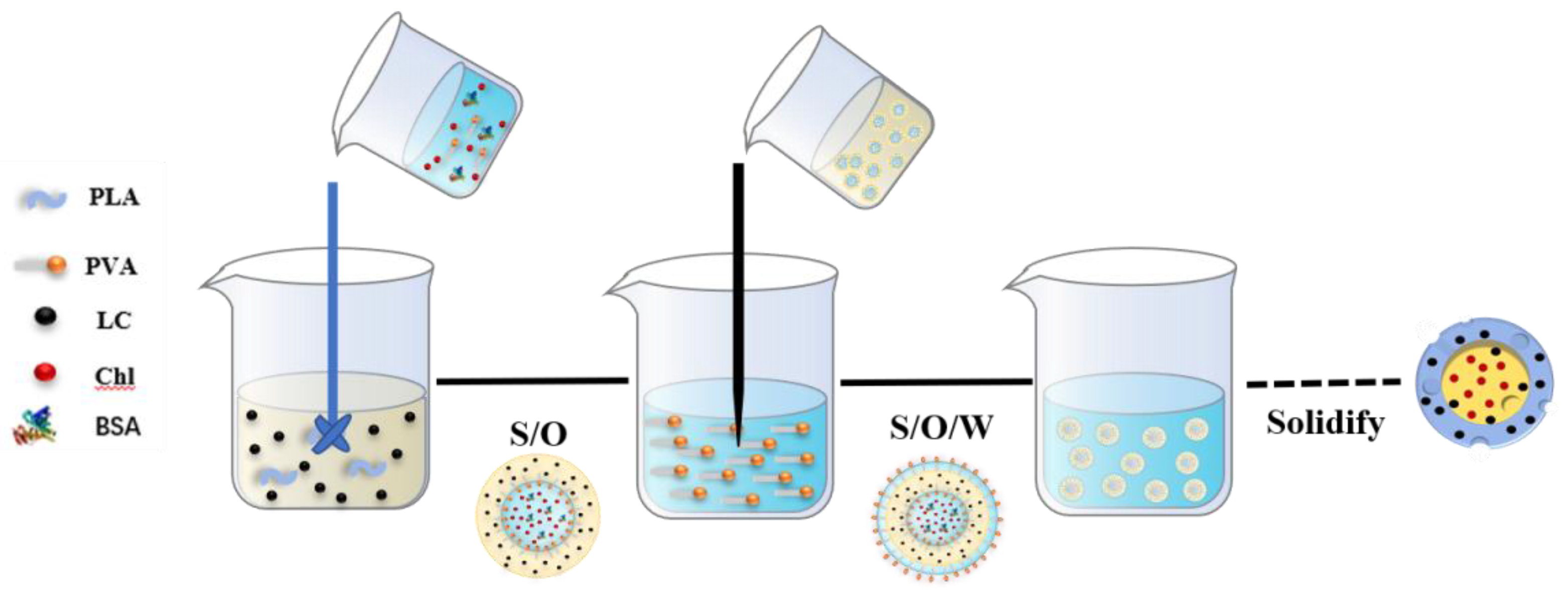
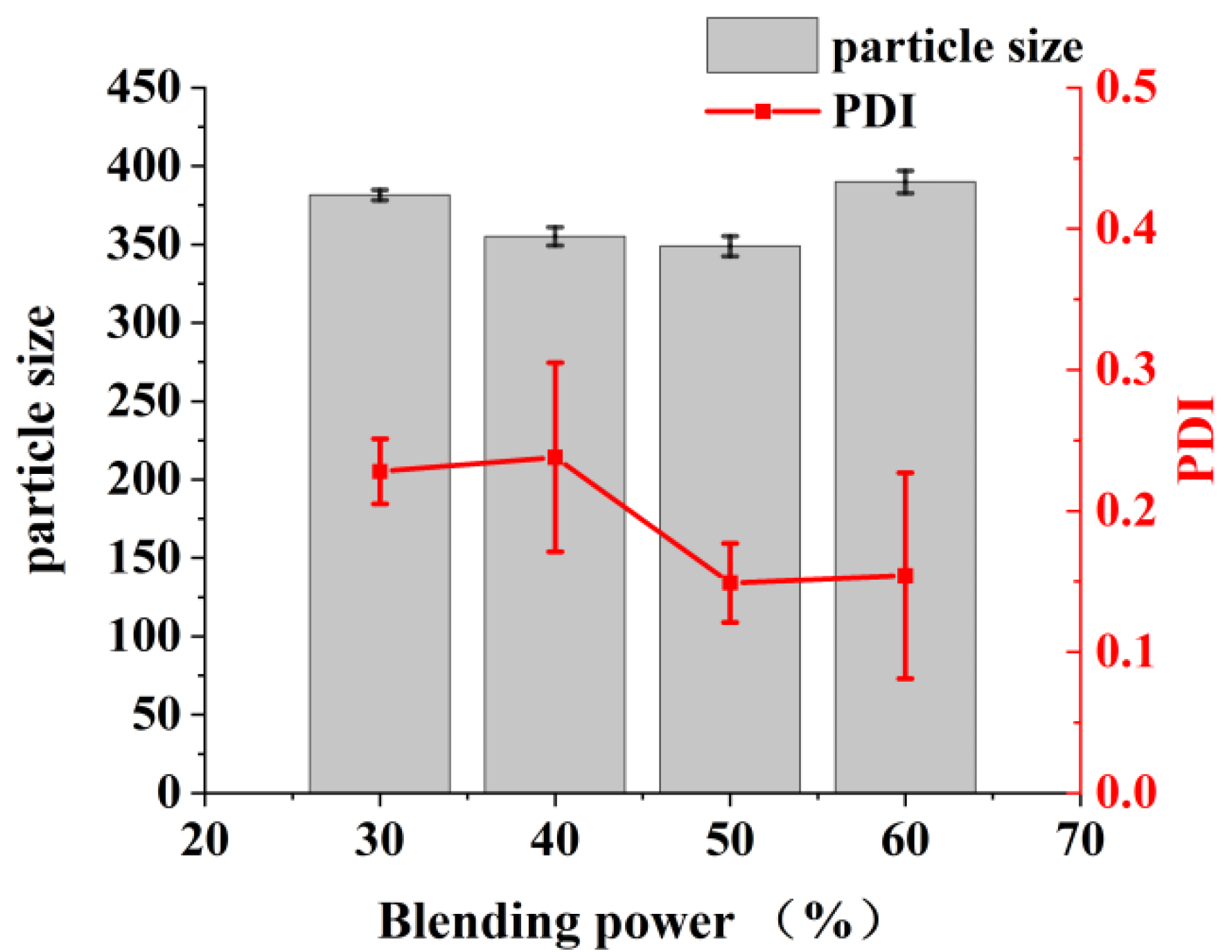
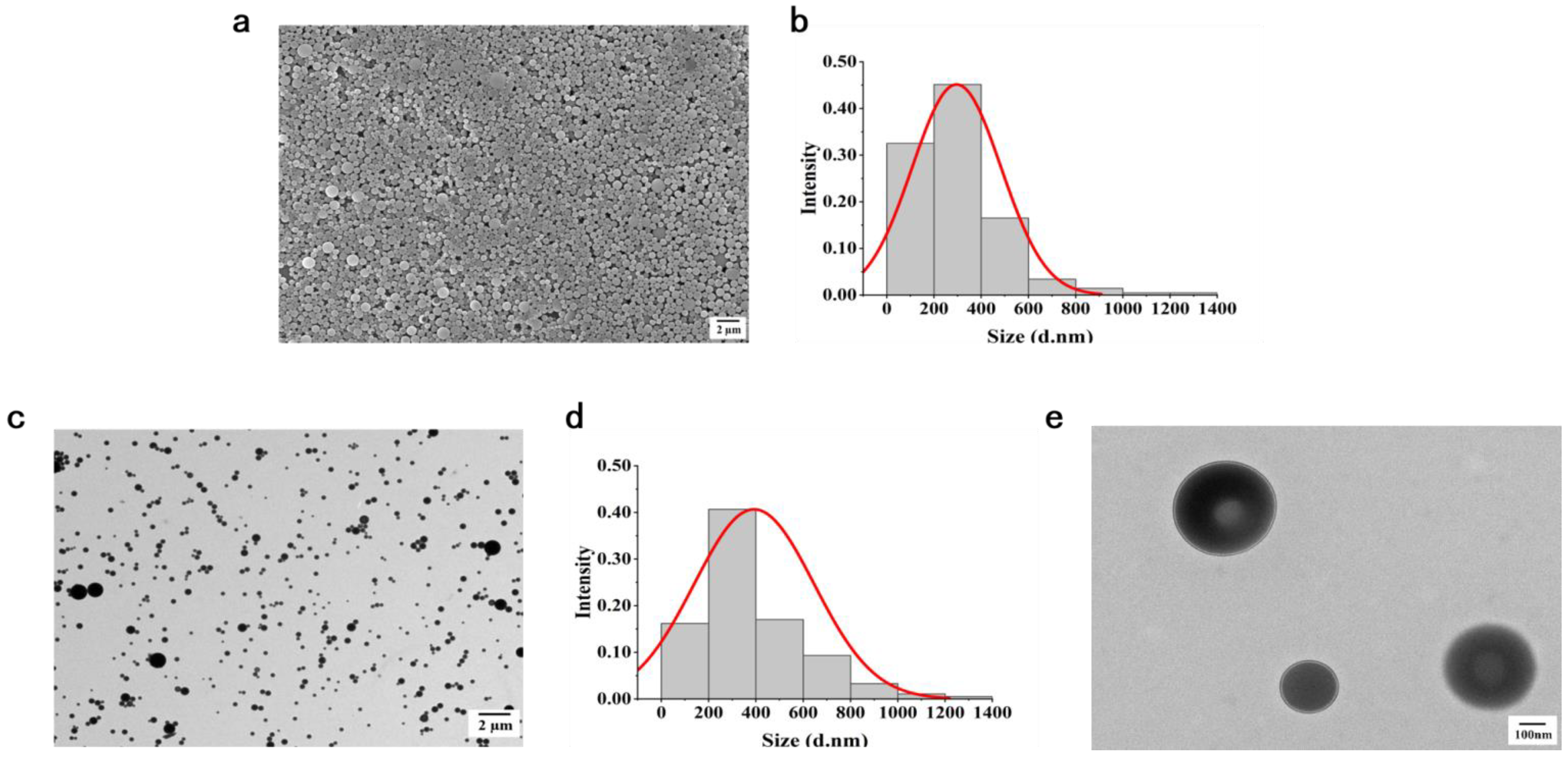

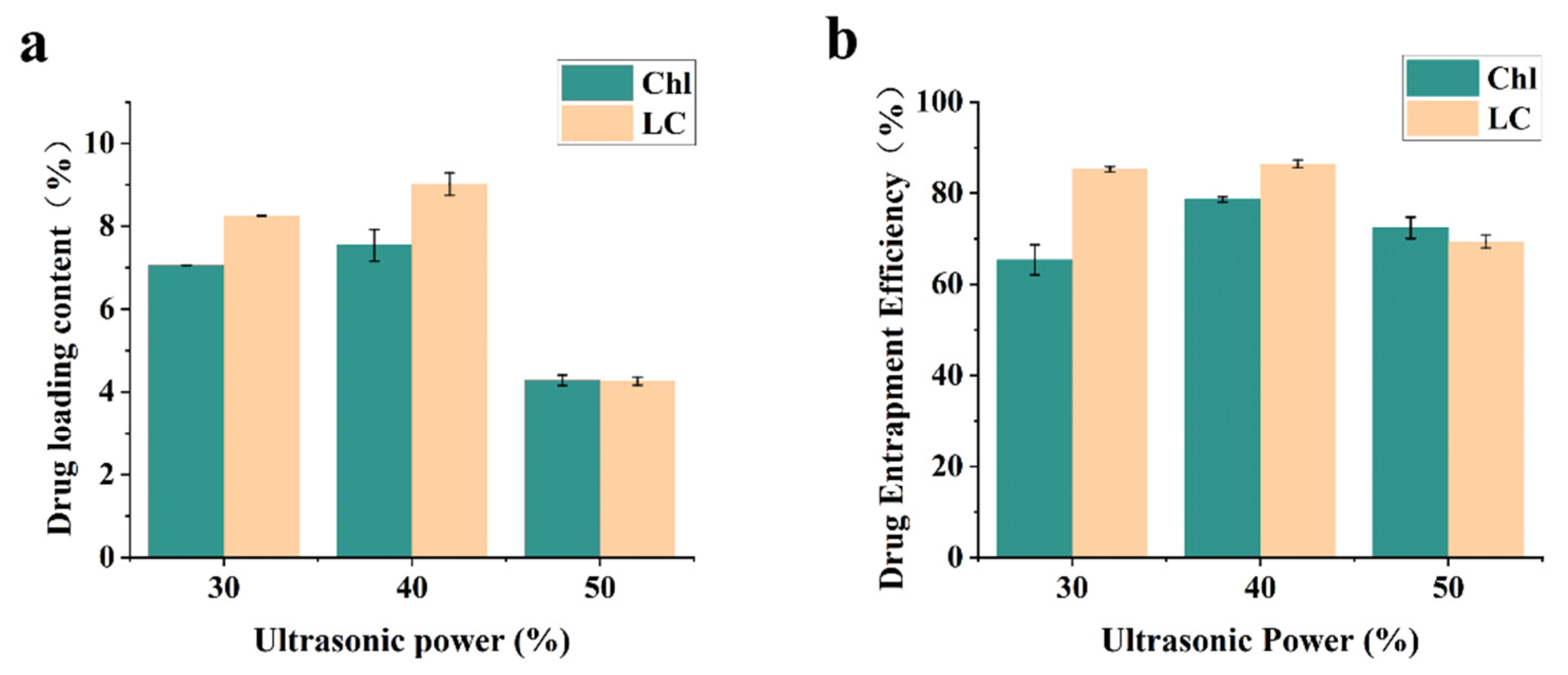

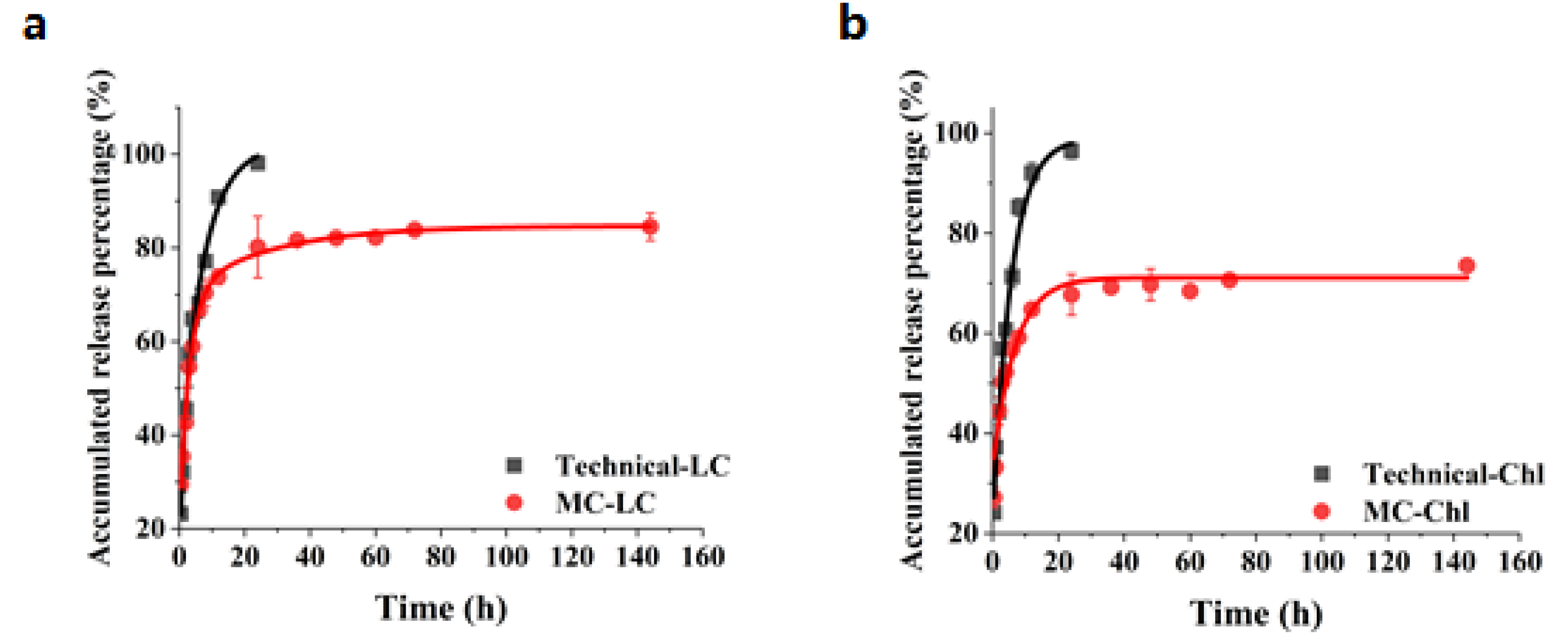
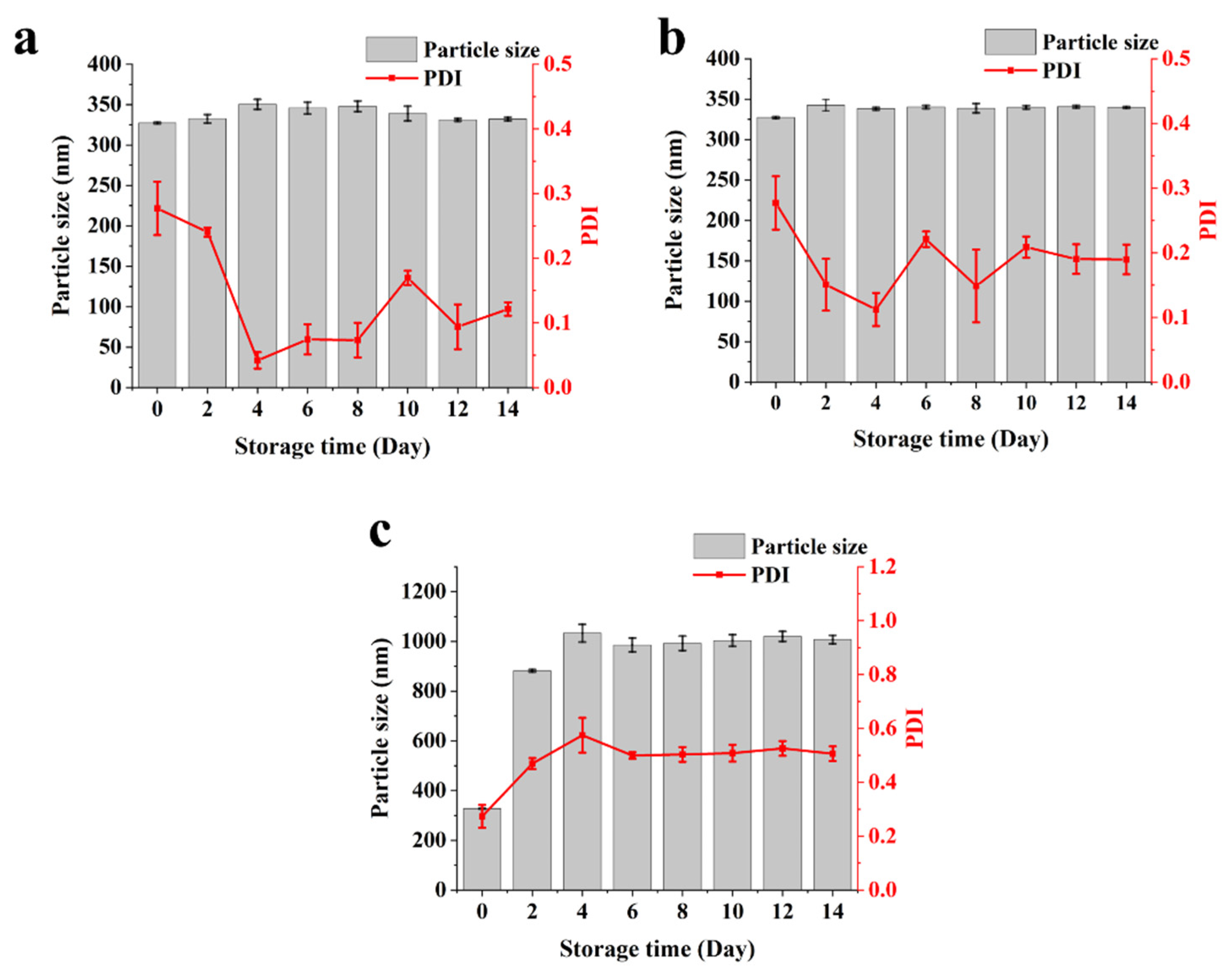
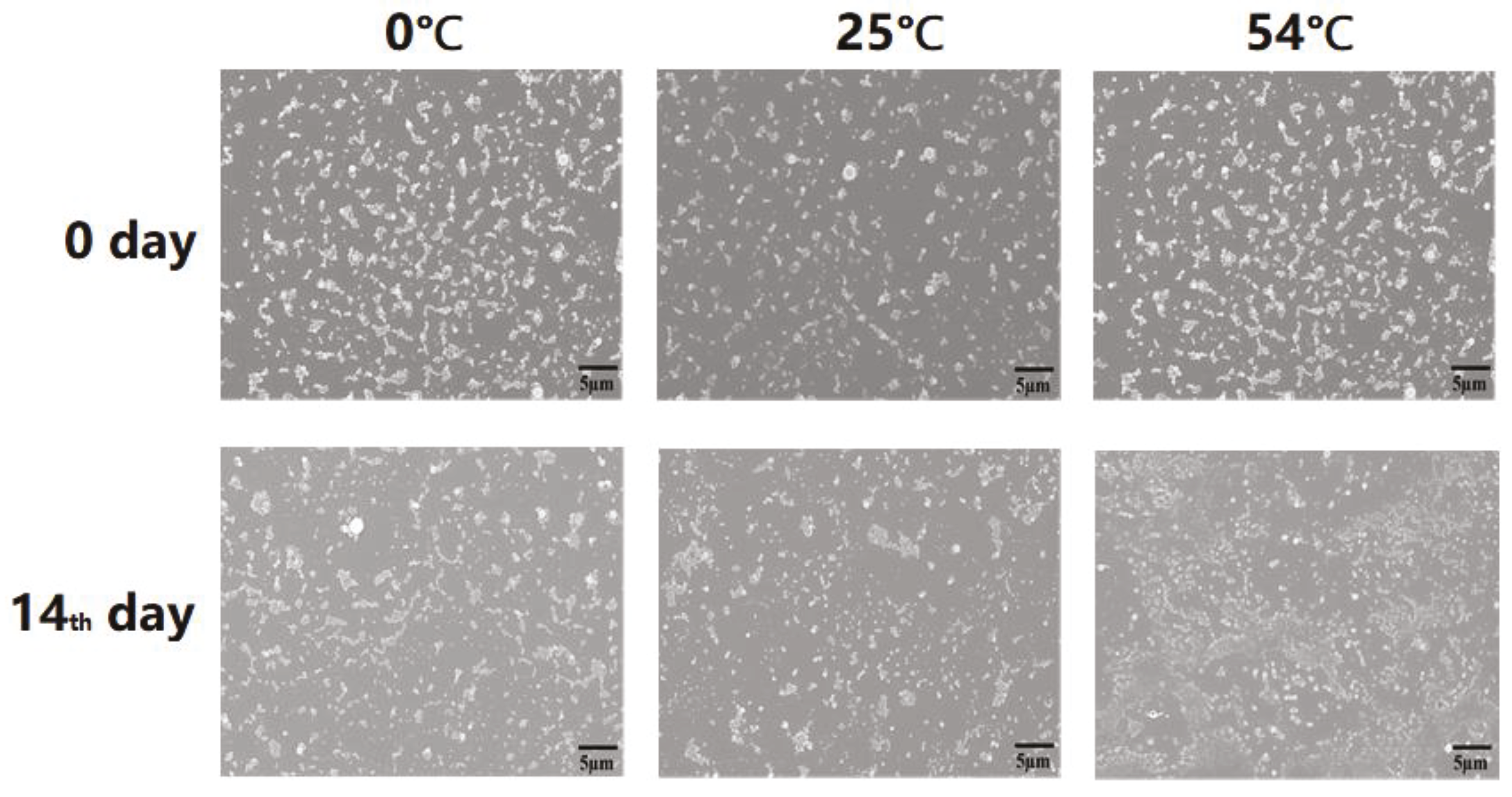


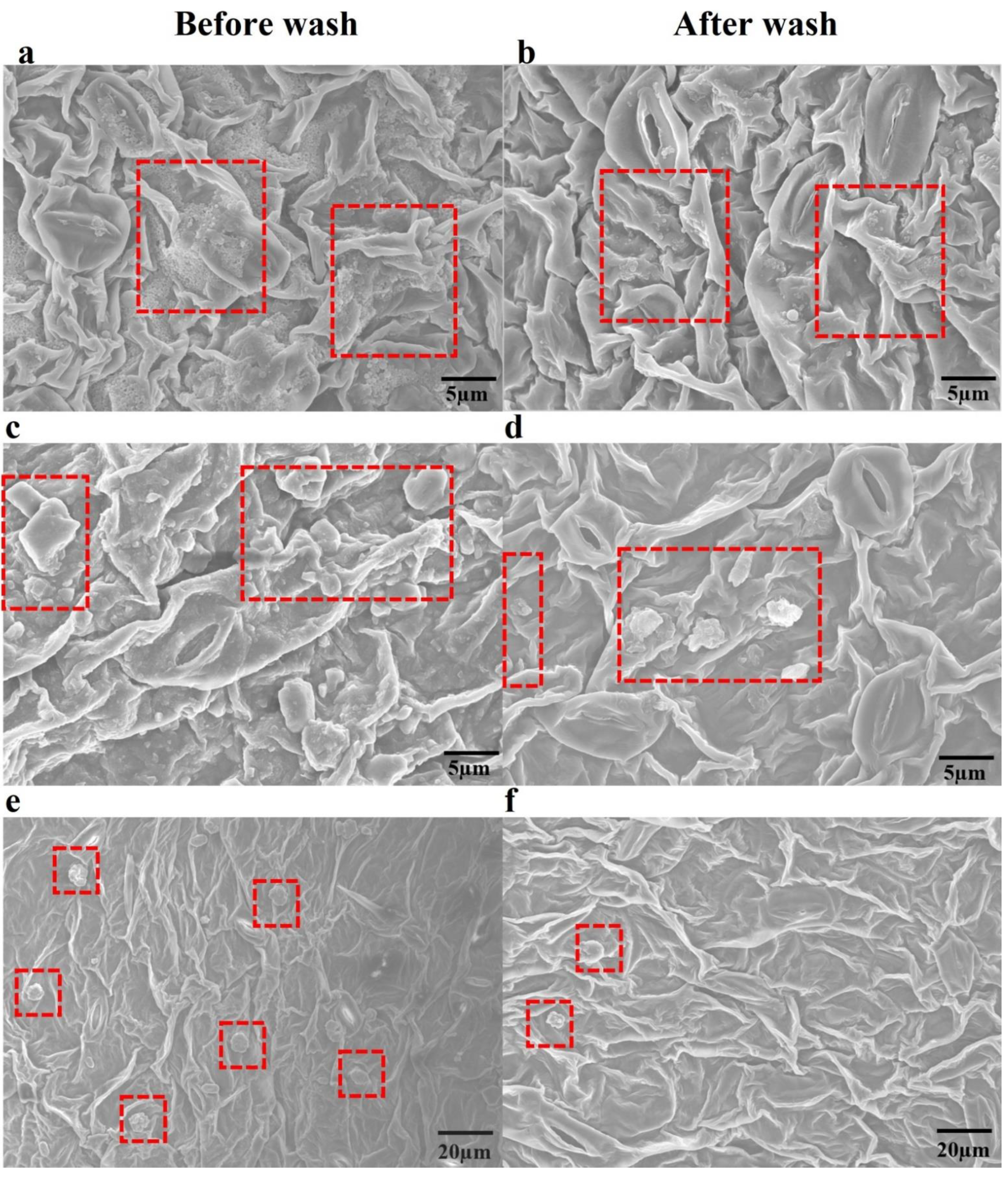
| Ratio of Chl to LC | Particle Size (nm) | PDI |
|---|---|---|
| 1:1 | 313.9 ± 1.1 | 0.215 ± 0.02 |
| 1:3 | 273.4 ± 1.2 | 0.166 ± 0.04 |
| 3:1 | 273.0 ± 3.7 | 0.169 ± 0.08 |
| Formulations | Regressive Equation | R-Square | LC50 (mg/L) |
|---|---|---|---|
| LC-WDG | y = 0.56 + 3.55x | 0.93 | 42.2 |
| Chl-WDG | y = 4.96 + 1.79x | 0.91 | 1.52 |
| LC and Chl-WDG | y = 1.38 + 1.65x | 0.95 | 1.05 |
| Nano-microcapsules | y = 5.37 + 1.38x | 0.92 | 0.39 |
Publisher’s Note: MDPI stays neutral with regard to jurisdictional claims in published maps and institutional affiliations. |
© 2021 by the authors. Licensee MDPI, Basel, Switzerland. This article is an open access article distributed under the terms and conditions of the Creative Commons Attribution (CC BY) license (https://creativecommons.org/licenses/by/4.0/).
Share and Cite
Feng, B.; Zhi, H.; Chen, H.; Cui, B.; Zhao, X.; Sun, C.; Wang, Y.; Cui, H.; Zeng, Z. Development of Chlorantraniliprole and Lambda Cyhalothrin Double-Loaded Nano-Microcapsules for Synergistical Pest Control. Nanomaterials 2021, 11, 2730. https://doi.org/10.3390/nano11102730
Feng B, Zhi H, Chen H, Cui B, Zhao X, Sun C, Wang Y, Cui H, Zeng Z. Development of Chlorantraniliprole and Lambda Cyhalothrin Double-Loaded Nano-Microcapsules for Synergistical Pest Control. Nanomaterials. 2021; 11(10):2730. https://doi.org/10.3390/nano11102730
Chicago/Turabian StyleFeng, Boyuan, Heng Zhi, Hongyan Chen, Bo Cui, Xiang Zhao, Changjiao Sun, Yan Wang, Haixin Cui, and Zhanghua Zeng. 2021. "Development of Chlorantraniliprole and Lambda Cyhalothrin Double-Loaded Nano-Microcapsules for Synergistical Pest Control" Nanomaterials 11, no. 10: 2730. https://doi.org/10.3390/nano11102730
APA StyleFeng, B., Zhi, H., Chen, H., Cui, B., Zhao, X., Sun, C., Wang, Y., Cui, H., & Zeng, Z. (2021). Development of Chlorantraniliprole and Lambda Cyhalothrin Double-Loaded Nano-Microcapsules for Synergistical Pest Control. Nanomaterials, 11(10), 2730. https://doi.org/10.3390/nano11102730










